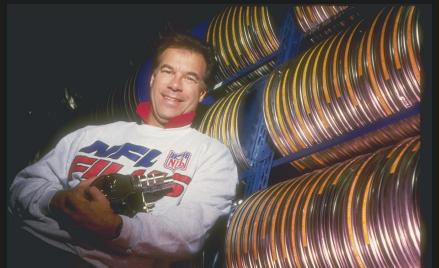Go see a special live performance of Slate’s sports podcast Hang Up and Listen in Washington, D.C. on Monday Oct. 1. Click here for more information and to buy tickets.
I’m deeply saddened by the news that NFL Films president Steve Sabol has passed away, succumbing to brain cancer at 69. Strangely so, since I did not know Steve very well. But I knew him a little, as a generous colleague as well as a talented filmmaker. A couple of years ago, I was working on a documentary of my own, and I contacted a producer I know at NFL Films to see if Steve would be willing to sit down for an interview. Our film was about the emerging crisis over head trauma, a topic that the head of NFL Films might be wary to discuss. But Steve didn’t hesitate. He did the interview, and for that I was very grateful.
I had been interviewed for a couple of NFL Films projects, and Steve was loyal to those, like me, who had contributed to NFL Films. And he respected NFL players, even one like me whose marginal career ended many years ago. On camera, he spoke frankly to us about his company’s dilemma over the popularity of its Crunch Course videos. The 1985 film begins with a shot of Joe Theismann getting smashed as Dolphins coach Don Shula explains, “The physical part of football is still the most important part.”
When the NFL banned head slaps and spearing, crackback blocks and clothesline tackles, these videos were suddenly celebrating illegal hits and had to be removed from circulation. Now, with the dangers of concussions fully acknowledged, Steve was deeply troubled about the game he loved and those who play it. He loved football, and for him football meant the players. The game is violent, and its violence is tied to its beauty. He worried about whether the essence of the game could be preserved while adequately protecting the players. But protecting the players was the most important thing.
He and his father Ed, along with Roone Arledge at ABC, essentially created what we see when we watch football. Arledge, with Monday Night Football, created football as show business, for primetime. The Sabols created football as epic drama and art. Ed Sabol (who is still living at age 96) set out to make football movies that looked like something out of the Hollywood studios, not just highlight films. He pioneered in using multiple cameras, stationary and handheld, shooting from different angles, and in slow-motion as well as full speed, to capture not just the action on field but the drama on the sidelines and the craziness in the stands. His son Steve built on that basic idea, bringing to bear his own love of art and cinema to the filming, editing, and scoring of the films. The object was to distill the essence of football and amplify it, to make an already larger-than-life sport larger and grander yet. Steve Sabol liked to call NFL Films’ first feature, They Call It Pro Football, the Citizen Kane of football films, and he didn’t overstate. Every game televised today incorporates NFL Films’ technical innovations and aesthetic.
I’ve seen NFL Films dismissed as PR for the NFL economic monster. OK, it serves that role, but I also see NFL Films as football’s epic poet, its major productions as the closest thing the sport has to an Iliad or Odyssey. A PR man couldn’t produce those films; they required an artist who loved the sport, surrounding himself with talented and creative people who loved it just as much. And this football-loving artist happened also to be a really decent and loyal guy. It so happens that a crew from NFL Films was at my house this past weekend, filming for a new project, and I asked about Steve Sabol’s health. Their pained responses spoke volumes to me as an outsider.
It will be interesting to see what happens with NFL Films now, as for the first time ever it will not be led by a Sabol. Whatever happens, Steve Sabol’s legacy is intact, in those close-ups of bandaged fists and sweat dripping from linemen’s faces in slow motion, as martial music soars and John Facenda’s “voice of God” intones the liturgy. We’ve lost an artist who had an impact on millions. He won’t be easily replaced.
